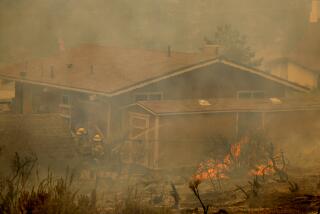It Isn’t Just Luck: Safety Measures Saving Homes
For Southern California homeowners, the 16,000-acre Topanga fire provided proof of an important lesson, fire officials said: Rigorous brush clearance and fire-resistant construction methods can substantially reduce the risk posed by the region’s inevitable wildfires.
Flames broke out Wednesday in an area along the Ventura-Los Angeles county line that has experienced major growth in the last two decades, most of it upscale hillside homes that were required to comply with the strictest fire-safety laws.
Two years ago, after massive fires destroyed more than 3,000 homes across Southern California, a Times analysis found that older homes that did not meet new fire-safety standards were much more likely to burn.
That lesson was reinforced Thursday as news coverage showed walls of flame leaping to within feet of tidy tract homes in one neighborhood after another, but not engulfing them.
Along with fire-resistant roofs, exterior walls and landscaping, the area was helped by rigorous brush-clearance requirements in Ventura and Los Angeles counties that kept tinder-dry sages and grasses at least 100 feet away from homes.
“I’m very impressed,” said weary Los Angeles Fire Battalion Chief Robert Hook, who had been up all night attacking the flames’ advance on upscale homes in the Ventura County community of North Ranch. “This community seems to have cleared all of their brush, and they are making it a lot easier for us to do our jobs.”
Property records show that the single home that burned to the ground, in the 7300 block of Santa Susana Pass Road, was built in 1946, long before stricter fire codes were in place. As of 8:30 p.m. Thursday, dozens of other homes were threatened but only one outbuilding in the Bell Canyon area had burned.
Residents in the path of the Topanga blaze seemed to have prepared for the worst.
Ashok and Usha Agarwal, who have lived in their North Ranch home for 11 years, cleared the brush around the two-story house this spring beyond the 100 feet required by Ventura County. And just last week, the couple finished replacing wooden siding on their home with a stucco exterior at a cost of $20,000.
For Usha, who had witnessed the devastation that wildfires caused two years ago, it was well worth the money.
“I’ll do anything to protect my house,” said Usha, standing outside the home Thursday morning with ashes in her hair.
At dawn, the couple watched firefighters cut a line behind their home and attack the fire with water hoses and retardant as the blaze descended the hill. Flames came within 200 feet of their property, she said.
After the devastating wildfires in 2003, a state panel of fire experts and public officials was convened to focus on potential reforms.
One of its recommendations, wider vegetation clearance around dwellings, was enacted Jan. 1, said Tom Hoffman, staff chief for fire prevention with the California Department of Forestry and Fire Protection.
Instead of 30 feet of clearance, homes in fire-prone rural areas that are not incorporated must have at least 100 feet free of combustible materials, he said.
The state is also updating building construction standards for certain risk areas, officials said.
New dwellings must have roofs of noncombustible material and screened vents to keep flying embers from entering attics, said Joe Garcia, a spokesman for the state fire marshal’s office.
By 2008, new-home exteriors, decking and windows must also be fire resistant, Garcia said. Though the changes apply only to projects in unincorporated areas, cities typically follow the state’s rules, he said.
Some cities and counties have already taken the lead.
Los Angeles and Ventura counties, for instance, have had stringent brush-clearance programs for many years, officials said.
Ventura County sends notices to 14,000 property owners each spring and gets close to 100% compliance, officials said. In 1991, about 1,000 homeowners violated the requirements, but by 2002, the number had dropped to 47.
One reason is the high cost of ignoring the order, officials said. In 2002, a $49,000 assessment was levied against a Thousand Oaks homeowners association in a neighborhood of million-dollar estates.
Los Angeles County has also reported a high level of compliance from residents in the foothill communities, said Assistant Fire Chief Johnny Jee. Most are required to clear a 100-foot zone around homes, but high hazard areas such as Malibu have a 200-foot standard, he said.
Inspectors check to make sure the work is done. If homeowners do not comply, the county sends crews to clear the dangerous brush and recoups the cost by adding it to the owners’ property tax bill, he said.
Wood shake roofs have long been outlawed for new construction, and it may be time to remove them from older homes as well, fire-safety experts say.
Many of the 2,000 homes threatened by the Topanga fire have tile roofs and stucco exterior walls. Still, there are pockets of older dwellings that are more vulnerable if homeowners have not made fire-resistant upgrades, officials said.
Ben Briscoe credited flame-retardant siding and roofing material with helping to save his hillside dwelling near Santa Susana Pass Road. A wall of flames burned within 75 feet Wednesday afternoon, he said.
“Boy, it was burning. Black smoke and flames going up 20 to 30 feet. And it came right through our place,” said the retired Chatsworth High School industrial arts teacher. “It’s an old home. But it’s been refurbished with fireproof Masonite on the outside and fiberglass shingles on the roof.”
His home was also threatened in the catastrophic fires of 2003, which came even closer, Briscoe said.
“We know fire up here,” he said. “But we’re in good shape.”
*
Times staff writers Hector Becerra, Daryl Kelley and Jia-Rui Chong also contributed to this report.
More to Read
Sign up for Essential California
The most important California stories and recommendations in your inbox every morning.
You may occasionally receive promotional content from the Los Angeles Times.











